
Air tour offers ideal photo viewpoints
TUSAYAN, Ariz. — There was a slight vibration when the engine of the small airplane started and the propellers on each side of the aircraft slowly began to spin in unison. I placed the headphones hanging on the seat in front of me over my ears, turned to channel 1 for English, and fastened my seat belt.
A few seconds later we were airborne, making our ascent to view one of the most spectacular natural wonders in the world — the Grand Canyon.
Each year, thousands of people make a pilgrimage to Northern Arizona for their very own peek into the vast canyons of Grand Canyon National Park.
While most people are satisfied to simply absorb the natural beauty unfolded before them from the Canyon’s popular South Rim Village or one of the many roadside stops, there are the few— myself included — that soon grow frustrated with the crowds and the often redundant views the rim affords.
To truly appreciate the vast splendor that belittles even the most well-traveled, there’s only one option— take to the air with one of the many aerial tour companies that circle over the Grand Canyon daily.
“We really loved the air tour,” said Matthew Harris, a visitor from New York.”We hiked a little, and that was fun, but being able to see it all from the air made you realize how big the Canyon really is.”
For my own airborne experience, I decided to fly with the tried and true— Grand Canyon Airlines. Beginning in 1927 with the Grand Discovery Tour, Grand Canyon Airlines has become a pioneer in the aerial tour industry.
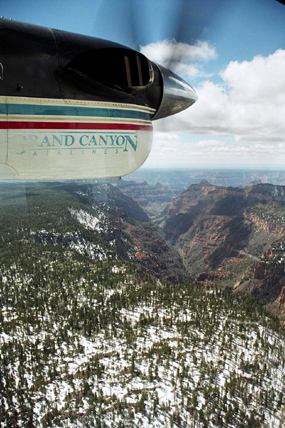 |
The canyon from the air (Photo by Tiffany Rainey). |
In addition to offering the first aerial tours of Grand Canyon National Park, the company holds a patent for its very own one-of-a-kind viewing aircraft, the Vistaliner. A modern, tour-minded rendition of the 1983 DeHavilland Twin Otter airplane, the 19-passenger Vistaliner has everything a tour plane should have.
The most notable features include panoramic windows and the addition of a fourth blade to each propeller allowing for a quieter ride that does little to disturb the wildlife in the area and makes listening to the tour narratives and music in between much easier for the passengers on board.
The stall capabilities of the Vistaliner— ones that make it seem as if you’re floating instead of soaring through the air at 100 miles per hour — don’t hurt either when it comes to photographing or videotaping your aerial experience.
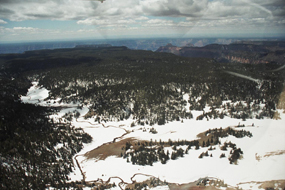 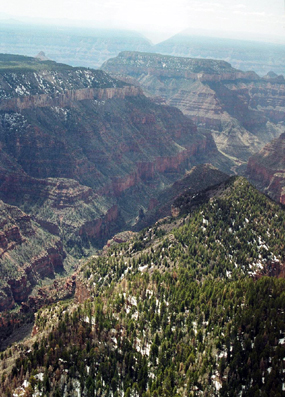 |
The pines and snow of both the north rim (top) and south rim (bottom) the Grand Canyon in the spring (Photos by Tiffany Rainey). |
“When we went up, I was really worried that I wouldn’t be able to get good pictures,” said Amber Adams. “I thought we’d be going too fast or the ride would be bumpy but it really wasn’t. The windows were just big enough for me to get the shots I wanted, especially of the river.”
The one-hour tour officially begins once the Vistaliner is safely off the ground and has begun its 100-mile loop over the Canyon.
I was busy snapping pictures out the endless windows when the enthusiastic, pre-recorded narrator broke in over the Bose noise-reduction headphones covering my ears to welcome me aboard.
The first order of business was to repeat the safety instructions from take-off and rattle off the many features of the Vistaliner that would make our tour possible.
Following the narrator’s short introduction was a tumultuous score of classical music that added to the excitement of the extraordinary view and, as I soon came to realize, broke up the narration to give you time to simply relax and enjoy the view.
While many tour guide books and nature enthusiasts argue that air travel over the Grand Canyon National Park disturbs the ambiance of the park, their arguments seem a bit overzealous.
Personally, I was never aware of any aircraft over the national park until I actually took my flight. The government, in an effort to balance the interests of tourists, air tour business, and nature conservancy, created several restrictions in 1987 that designated specific flight paths, altitudes, and flight times for companies offering air tours in order to limit the disturbance caused by these tours.
Some companies, such as Grand Canyon Airlines, have even gone so far as to alter their aircraft to reduce sound, though this is not a government restriction.
Alan R. Stephen, vice president of Grand Canyon Airlines, made a valid point when presenting the case of the U.S. Air Tour Association before the U.S. Senate on October 2002.
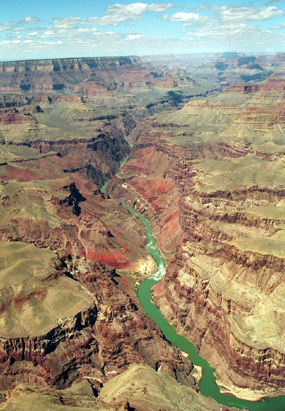 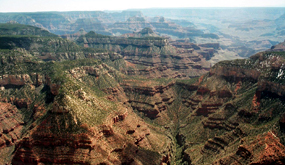
|
The Colorado River and other canyon views from the air (Photos by Tiffany Rainey). |
“Air tourists require no roads or trails, campsites or sanitation services, leave no garbage, pick no flowers and take no souvenirs. Although aircraft sound is the sole short-coming of air visitation, air tour sound is temporary and can be mitigated by choosing appropriate routes and altitudes so any associated sound impact is brief, if not virtually inaudible, for the vast majority of park ground visitors,” he said.
With this in mind, it seems a little overbearing to say that air tourists cause any more problems for the environment than the thousands of hikers, campers, and ground tourists that visit the region daily.
The rest of my flight was spent pressing my face as close as I could to the window to get the best view possible of the Grand Canyon like I had never seen it before. My three previous days on the South Rim hadn’t prepared me for all that the canyon had to offer.
For the first time I saw the elusive Colorado River, which is about 300 feet wide, 30 to 40 feet deep, and changes color with the seasons according to my narrator, and could almost see rafters making their way through its treacherous rapids.
I had heard there was a river buried somewhere between the sloping climbs of the canyon walls, but I can assure you there’s nothing like seeing it snaking its way along for yourself.
The view of the North Rim was equally spectacular. A far cry from the desert-like South Rim, the North Rim was dotted with thousands of evergreen trees capped in white, powdery snow though it was early spring.
The North Rim is home to around 300 species of birds and around 250 species of animals, among these are mountain lion and nearly 35,000 mule deer.
It was also both strangely and refreshingly absent of any sign of human life.
The all-knowing narrator, which seems to answer your unasked questions almost before you can even think of them, said this was because of the higher altitude on the north side and the thick layer of snow that usually coats the region from October to May.
The most amazing part of the flight, however, wasn’t the entrancing scenery below or the intriguing, self-sufficient aircraft that carried us through the air.
It was the way that they all fit together— the flight, the canyon, the view— to give you a sense of solitude and make you feel that you are the first person ever to lay eyes on the beautiful dip in the Earth below.
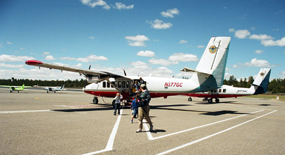 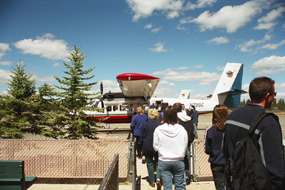 |
Grand Canyon National Park Airport in Tusayan is the starting point for many air tours of the canyon (Photos by Tiffany Rainey). |
More than anything, the Vistaliner gave me something that I am often too busy for— time to really appreciate on the natural beauty that can so easily pass us by.
Maybe it was the individualized headsets or the panoramic windows that made me feel like I was actually soaring through the air on my own, super hero-style, with no one to interrupt my thought process or obstruct my view but I think that was only part of it.
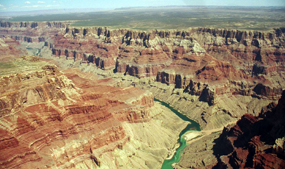 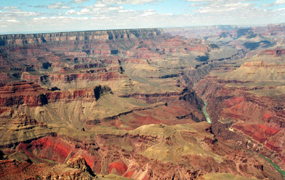 |
Canyon views are best on clear days (Photos by Tiffany Rainey). |
More than anything I think it was my amazement and awe at the canyon that carried me miles away from the family of four beside me and deep into the astounding world below.
It wasn’t until the wheels of the Vistaliner touched down on the runway with ease that I realized an entire hour had passed in what seemed like only a few minutes.
I removed my headphones and there were a few moments of initial shock as I was forced to come to terms with my re-entry into the world.
It felt a little like leaving the theater after an especially riveting movie — disorienting, surreal, and with the persistent pang of realization that the experience is actually over no matter how long you wish you could hide yourself inside of it.
I waited for everyone else to exit the aircraft before I finally stood up, stretched my legs, and bade farewell to the captain. On my walk back to the terminal I couldn’t help but remember the narrator’s quote from Clarence Dutton, one of the pioneers of the Grand Canyon:
“[The] Grand Canyon is never the same. Even from day to day, hour to hour.”
I smiled to myself, remembering my own special hour with the canyon, one that will not soon be forgotten.
If You Go
In addition to Grand Canyon Airlines, there are several other aerial tour companies that fly out of Tusayan Airport just south of the park entrance. These companies provide tours in a variety of aircraft, ranging in price from $60 to $227 and offer a multitude of individualized packages from which to choose:
- Papillon Grand Canyon Helicopters
800-528-2418, http://www.papillon.com - Air Grand Canyon / Sky Eye Air Tours
800-247-4726, http://www.airgrandcanyon.com - AirStar Helicopters
800-962-3869, http://www.airstar.com - Kenai Helicopters
800-541-4537, http://www.flykenai.com - Grand Canyon Airlines
800-528-2413, http://www.grandcanyonairlines.com
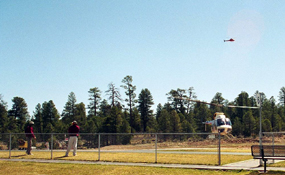 |
In addition to small airplane tours, helicopter tours are also available at Grand Canyon National Park Airport (Photo by Tiffany Rainey). |
A few tips:
- Airplanes are usually less turbulent than helicopters.
- The best time to fly is early in the morning-the turbulence is lowest midday or before.
- If English isn’t your first language, don’t worry. Grand Canyon Airlines and many others narrate their tours in several languages including German and Korean.
- If you bring along a video camera and you find that the tour is broadcast over headphones make sure to ask an employee of the company for a cord to connect your camera so that you will be able to record the narrator as well as the view.
- Some aerial tour companies offer discounted rates, especially around noon, so remember to ask when you make reservations.
- Ask the front desk of your hotel about special packages or shuttles that include air tours. Most land tour companies have package deals that will allow you to see the Canyon up close as well as in the air and usually for a discounted price.
- Always make reservations ahead of time. Seating is limited and fills up quickly, especially during prime tourist seasons.

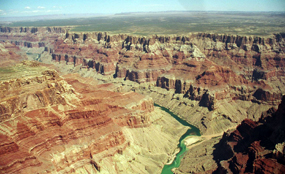
Comments are Closed